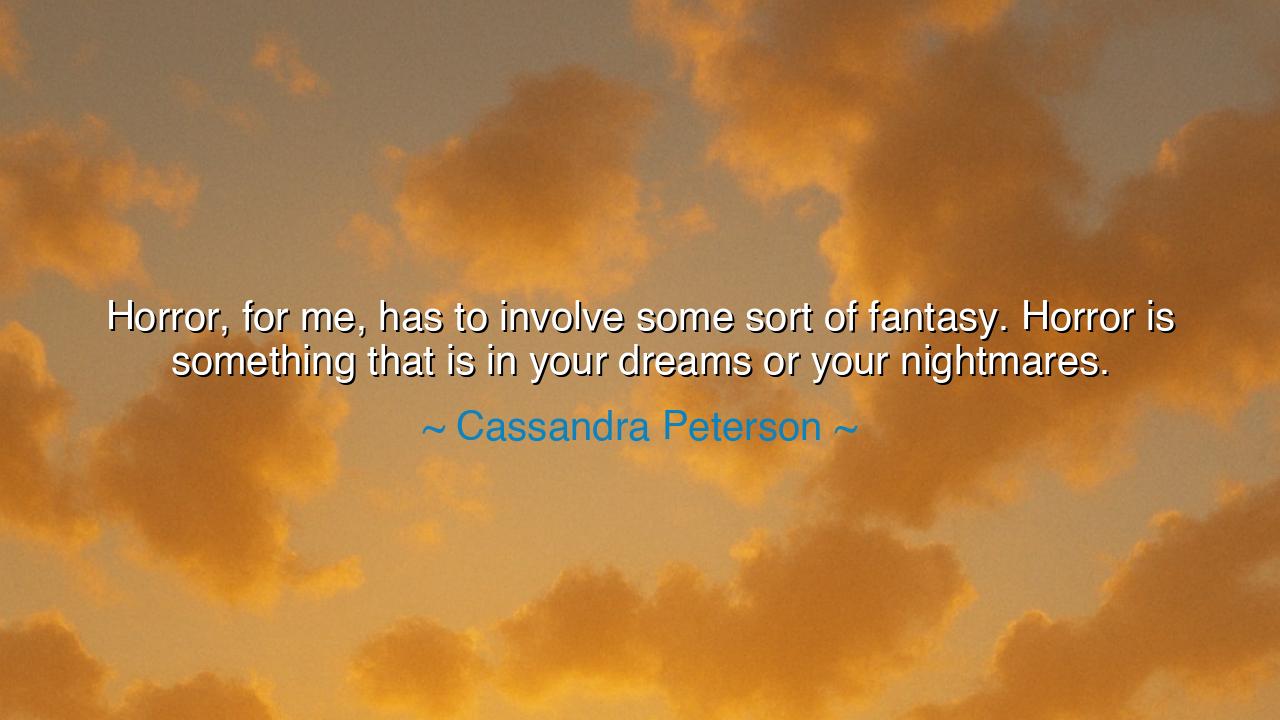
Horror, for me, has to involve some sort of fantasy. Horror is
Horror, for me, has to involve some sort of fantasy. Horror is something that is in your dreams or your nightmares.






The words of Cassandra Peterson, the legendary performer behind the immortal figure of Elvira, Mistress of the Dark, carry within them the heart of the human fascination with fear: “Horror, for me, has to involve some sort of fantasy. Horror is something that is in your dreams or your nightmares.” Beneath their simplicity lies a truth both ancient and profound—that true horror is not found in the mundane or the merely cruel, but in the realm of the imagination, where the boundaries between waking and dreaming dissolve. Peterson speaks as one who has danced with shadows and learned that the power of fear is not in what we see, but in what we believe could exist beyond the veil of reality.
Cassandra Peterson, born in the world of performance and reinvention, found her place in the strange and delightful kingdom of fantasy horror. As Elvira, she became both queen and jester of the dark—embracing the monstrous while laughing at it. Her vision of horror was not merely to terrify but to enchant, to transform the grotesque into something sublime and captivating. Thus, when she speaks of dreams and nightmares, she reveals that horror is most potent when it becomes mythic—when it ceases to be only blood and bone, and becomes instead a mirror for the soul’s own buried fears and forbidden desires.
The origin of this belief lies in the earliest ages of humanity, when our ancestors first gathered around the fire and whispered tales of the supernatural—of spirits that walked in the dark, of beasts that devoured the careless, of gods whose wrath could strike without warning. These stories were not merely meant to frighten; they were ways of giving form to the unknown, of transforming chaos into imagery, fear into story. In this way, horror was born from fantasy, and fantasy from the human need to comprehend mystery. Thus, Peterson stands as an inheritor of that ancient art: to awaken fear not as cruelty, but as revelation—to remind us that our nightmares are also gateways to understanding ourselves.
Consider the tale of Mary Shelley, who, in the throes of a dream, saw a vision of a creature assembled from the remnants of the dead, and from that vision gave birth to Frankenstein. Her horror was not a reflection of gore, but of imagination—the dread of man’s own hubris, the terror of life out of balance with creation. That story, like Peterson’s words, reminds us that true horror is born from dreams, from the fantastic, from the mind’s attempt to grapple with its own power. Shelley’s nightmare became a myth that transcended time, proving that what we fear in the dark is not the monster itself, but what it says about the soul of humanity.
When Peterson speaks of horror as something that lives in nightmares, she invites us to recognize fear as a form of poetry—a dark art that thrives on the surreal and the symbolic. The monsters of fantasy, whether vampires or ghosts, are never only external creatures; they are emblems of our own shadow selves. The vampire is the hunger of desire; the ghost, the voice of regret; the demon, the embodiment of guilt. To weave horror with fantasy, then, is to explore not only terror, but truth—to give our inner darkness a shape so that we may look upon it and name it. In this way, horror becomes not just fearsome, but cathartic.
And yet, there is beauty in this revelation. For when horror dwells in the realm of fantasy, it also grants us power over it. Dreams may frighten us, but they also belong to us—they spring from the same imagination that gives rise to art, to creation, to transformation. Peterson’s words, though spoken in the context of her craft, carry a universal teaching: that we must learn to face our fears not by denying them, but by imagining them into meaning. Just as she donned the guise of the gothic and made it joyful, so too can we transform the dark corners of our own minds into spaces of discovery.
Therefore, O listener, take this lesson as your own: when fear visits you—whether in dreams or in life—do not flee from it as from an enemy. Instead, seek the fantasy within it, the symbol it carries, the truth it conceals. For every nightmare hides a message, and every shadow contains a spark of light. Let your imagination be the lantern that guides you through the labyrinth of fear. And remember, as Cassandra Peterson teaches, that horror is not simply the grotesque, but the mysterious language of the subconscious—the ancient song of awe and wonder that whispers to us even in the darkness.
So when next you dream, and the strange and the terrifying come to visit, do not wake in terror—listen. For perhaps, like the poets, the prophets, and the storytellers before you, you will find that what haunts you in the night may yet become your greatest source of wisdom, your richest well of creation, and your truest reflection of the infinite depths within the human soul.






AAdministratorAdministrator
Welcome, honored guests. Please leave a comment, we will respond soon